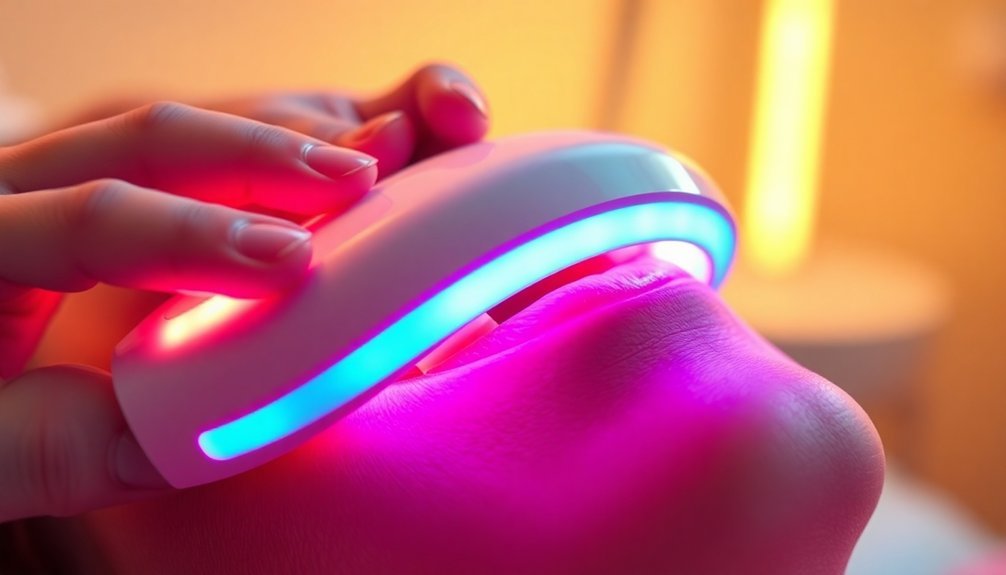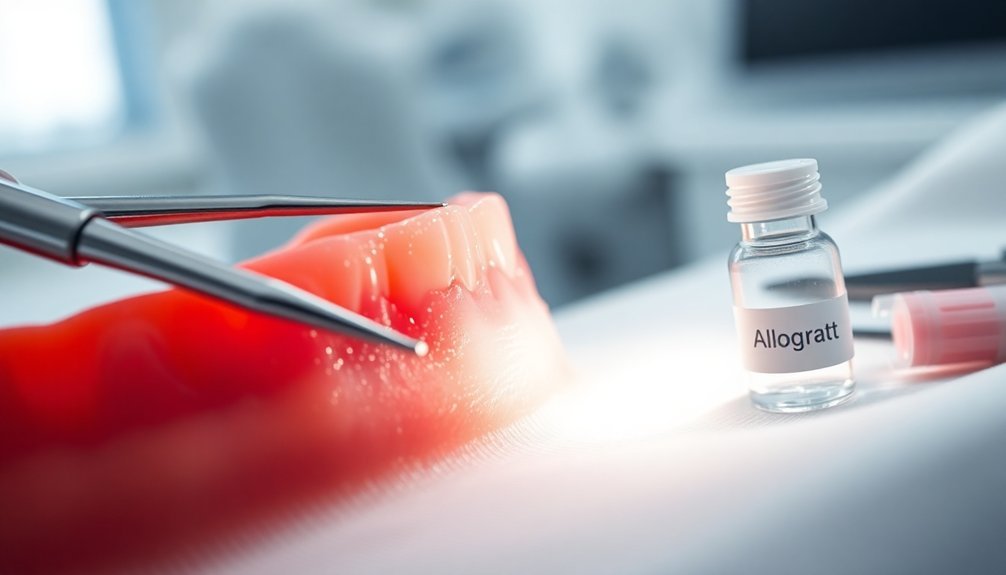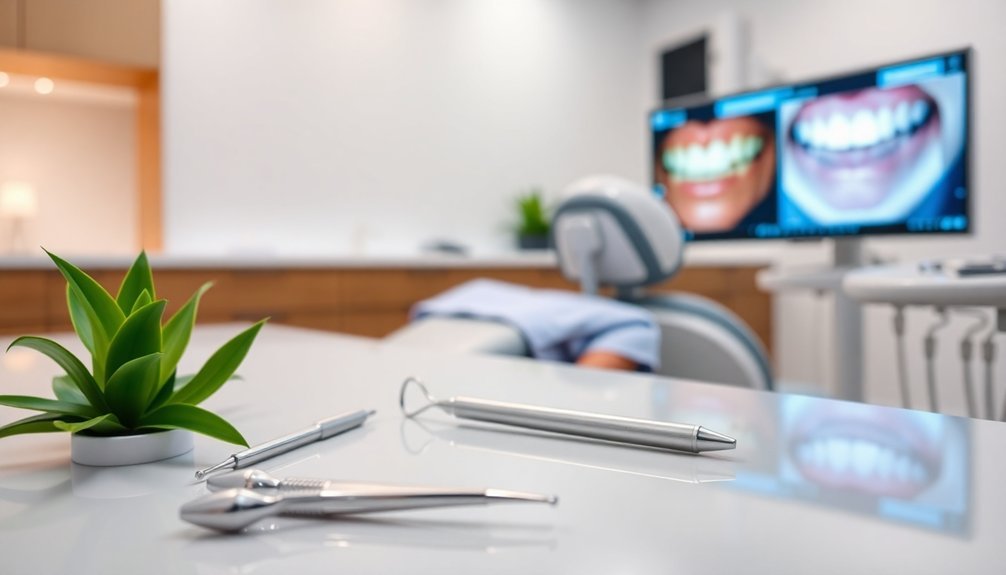To speed up your recovery from gum treatments, consider these top five options. Infrared therapy promotes circulation and reduces inflammation, enhancing healing. Connective tissue grafts and allografts support tissue regeneration while minimizing complications. Laser therapy offers a minimally invasive approach that allows you to get back to normal activities quickly, healing tissues efficiently. Finally, don't underestimate nutritional support—ensure you get plenty of Vitamin C, D, calcium, and omega-3 fatty acids to boost your recovery. By picking the right treatments and nutrients, you can foster healthier gums. Keep exploring to discover even more options for ideal healing!
Infrared Therapy Benefits

Infrared therapy offers several impressive benefits for your gum health that can greatly aid in recovery times. First, it promotes circulation and healing by boosting blood flow to your gums and teeth. This increased circulation delivers essential nutrients and oxygen to your oral tissues, expediting healing, especially after dental procedures. Moreover, it enhances overall well-being by improving blood circulation throughout the body.
You'll find that it helps reduce post-procedure inflammation, supporting overall oral health and resilience against infections.
Additionally, infrared therapy facilitates detoxification, allowing your body to eliminate toxins through sweat. By lowering your overall toxin load, it contributes to healthier gums and might even help prevent gum disease. You'll notice these benefits enhance your overall wellness.
Moreover, infrared therapy considerably reduces inflammation and alleviates pain. If you're dealing with gingivitis, periodontitis, or TMJ issues, you'll appreciate how infrared therapy relaxes jaw muscles and provides non-invasive pain relief.
It's an effective way to prevent gum recession and tooth loss while managing dental discomfort.
In essence, incorporating infrared therapy into your routine can effectively prevent and treat gum diseases, speed up recovery after dental procedures, and support your immune system to combat oral infections.
Connective Tissue Graft
A connective tissue graft is a highly effective procedure used to treat gum recession and improve the overall health of your gum tissue. During this procedure, tissue is harvested from the roof of your mouth, specifically from underneath the top layer of the palate.
Your dentist will create a pouch in the gums where this tissue is placed and stitched onto the existing gum tissue. After closing the flap and suturing the palate, you'll initiate a healing process. This grafting method not only helps in covering exposed roots but also provides coverage for exposed roots and improves gum contour.
Here's what you can expect:
- Initial swelling and tenderness for the first few days.
- Surface cells of the graft may appear whitish or yellowish, but this is normal.
- You can gradually return to a normal diet by the second week.
- After several weeks, the graft site should feel stable and firm.
Post-operative care involves avoiding rinsing and sticking to a soft food diet initially. Ice packs can help manage pain and swelling.
Allograft Advantages

Choosing an allograft over a traditional connective tissue graft can considerably enhance your recovery experience. With no need for a second surgical site, you'll face fewer post-operative complications and a reduced surgical footprint. This minimally invasive approach not only shortens surgery times but also leads to less pain during and after the procedure.
Allografts serve as effective scaffolds for new tissue growth, helping regenerate lost gum tissue while promoting the formation of a healthy gingival margin. They enhance the stability of surrounding gums, which is vital for dental implants, and provide root coverage to prevent further recession. Additionally, early intervention is crucial to avoid severe consequences often associated with untreated gum recession.
From an aesthetic standpoint, allografts blend seamlessly with your natural gums, improving your smile's overall appearance and symmetry. They also help strengthen existing gum tissue against bacteria, reducing tooth sensitivity associated with gum recession.
Clinically, allografts yield promising results with long-term stability. You can expect predictable outcomes, fewer visits to your dental practice, and a faster return to normal activities—all contributing to your comfort and satisfaction in your recovery journey.
Laser Therapy Applications
Laser therapy represents a groundbreaking advancement in periodontal treatments, offering an effective way to address gum issues with minimal discomfort. By utilizing specialized lasers, this innovative method targets diseased gum tissue and harmful bacteria. The laser's concentrated light energy vaporizes pigmented bacteria and inflamed tissues, reducing bacterial levels while promoting healing.
With the ability to precisely target infected areas, laser therapy minimizes trauma to healthy tissue, ensuring a more comfortable experience.
Here are some key benefits and applications of laser therapy for your gum health:
- Minimally invasive: Less pain, swelling, and bleeding compared to traditional surgery.
- Quick recovery time: Many patients resume normal activities within a day or two.
- Effective bacterial elimination: Reduces bacteria in periodontal pockets, decreasing infection risk.
- Regeneration support: Promotes tissue regeneration and gum reattachment for enhanced healing.
Laser therapy isn't only effective for treating periodontal disease but also assists in procedures like gum reshaping and gingival contouring, giving you healthier gums and a more aesthetically pleasing smile.
With its precise approach and quick recovery, it's a valuable option for anyone seeking gum treatment.
Nutritional Support for Healing

Ideal nutritional support plays an essential role in speeding up the healing process for your gums. Focus on including important nutrients that promote recovery, such as Vitamin C, which is critical for wound healing and can be found in citrus fruits, strawberries, and broccoli.
Don't forget about Vitamin D; it helps with bone mineralization and can be obtained from sunlight, fatty fish, and fortified dairy products.
Calcium is also significant; it strengthens your teeth and bones, so incorporate dairy, leafy greens, and fortified plant-based milk into your meals. Omega-3 fatty acids, found in salmon and walnuts, help ease inflammation, while lean protein sources like chicken and legumes are key for tissue repair.
To aid healing, include soft foods like soups and smoothies that are easy to digest. Yogurt is great for providing beneficial bacteria, while mashed vegetables deliver important nutrients without straining your gums.
Conversely, avoid hard, crunchy, and spicy foods to prevent irritation. Stay hydrated to promote saliva production, combat oxidative stress with antioxidants, and maintain a balanced diet for ideal recovery.
Frequently Asked Questions
How Long Does the Recovery Process Typically Take for Gum Grafts?
Recovery from gum grafts typically takes 7-10 days. You'll feel pain lessen within 2-4 days, and most swelling reduces by the end of the first week. Long-term healing may extend up to three months.
What Should I Avoid Eating After a Gum Graft Procedure?
After a gum graft, avoid hard, crunchy foods like nuts and chips, as well as spicy items and anything sticky or chewy. Focus on soft, bland foods to promote healing and reduce discomfort.
Can I Brush My Teeth After Gum Grafting?
You shouldn't brush the grafted area immediately after gum grafting. Stick to rinsing gently with salt water. After 48 hours, you can clean cautiously with a Q-tip, but avoid direct brushing for at least a week.
What Signs Indicate a Complication During Recovery?
During recovery, watch for signs like excessive bleeding, persistent swelling, unusual pain, or signs of infection such as pus or fever. If any occur, contact your dentist immediately to address potential complications.
Are There Any Lifestyle Changes Needed Post-Gum Graft?
Yes, you'll need to limit physical activity, modify your diet to soft foods, maintain strict oral hygiene, and manage pain and swelling effectively. These lifestyle changes help guarantee a smoother recovery process after your gum graft.
In Summary
In conclusion, choosing the right gum treatment can speed up your recovery considerably. Whether you opt for infrared therapy, connective tissue grafts, allografts, laser therapy, or focused nutritional support, each option offers unique benefits. By considering your specific needs and consulting with your dental professional, you can make an informed decision that promotes healing. Remember, taking care of your gums is essential for your overall oral health, so don't hesitate to explore these effective treatments!





Leave a Reply